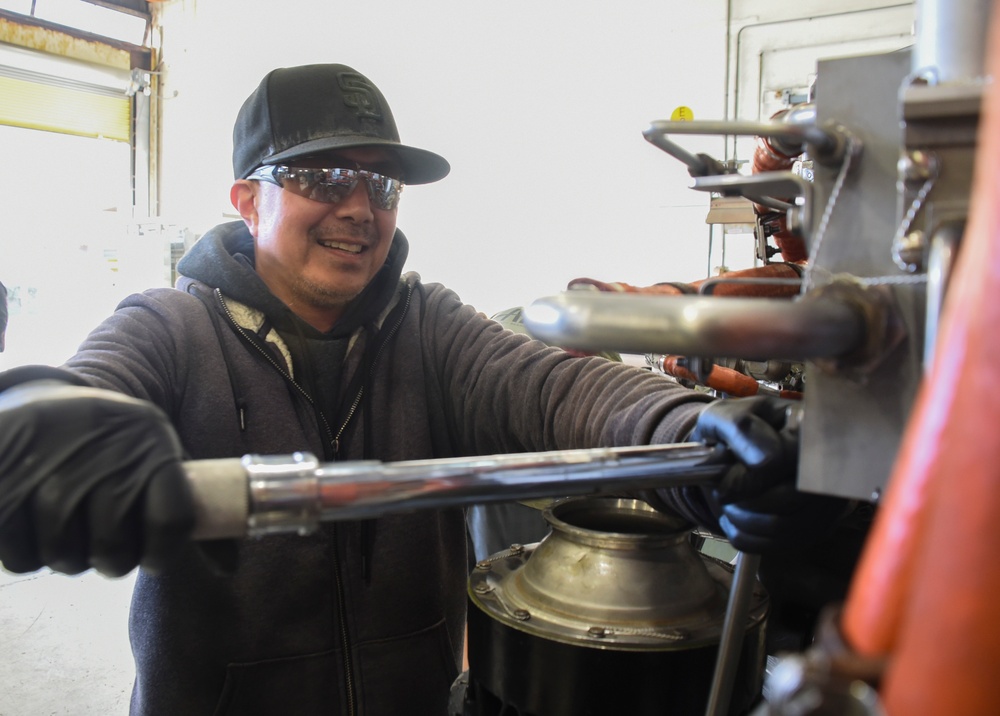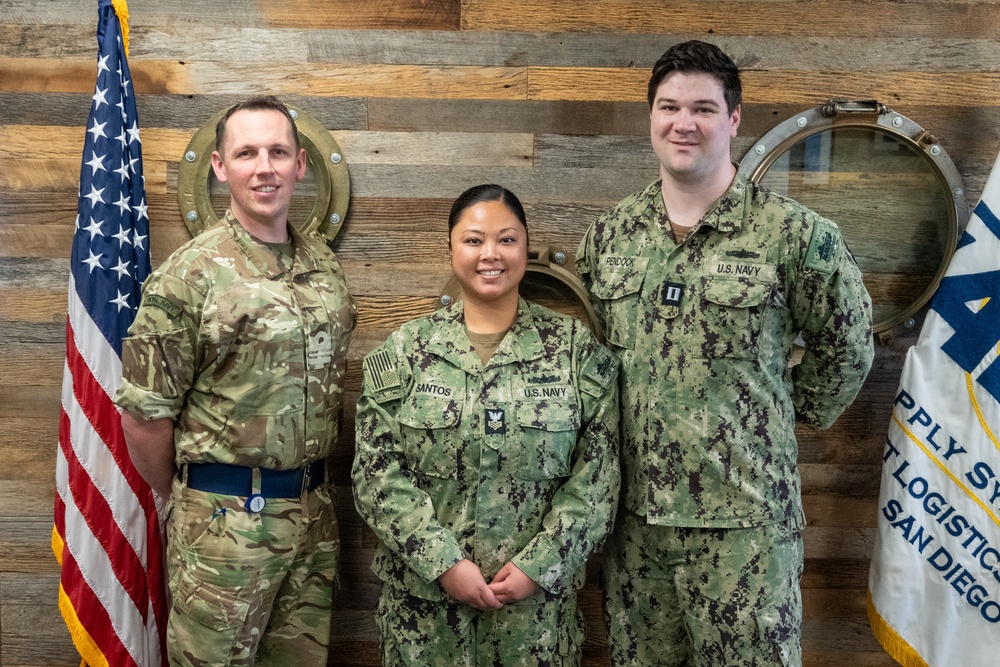Edited by Capt. Ryan Baum and Lt. Drew Pendock via NAVSUP FLC San Diego Public Affairs
San Diego, Calif. – Current conflicts worldwide and the potential for future conflicts are high in today’s geopolitical climate. The United States Navy’s fleet readiness depends on the logistics system being able to keep ships and Sailors supplied with the materials they need to do their jobs. Logistics Support Representatives (LSR) provide Naval Supply Corps Officers (SUPPOs) the ashore support they need to get ships sea-ready, and the NAVSUP Fleet Logistics Center San Diego (NAVSUP FLCSD) Reserve component is at the forefront of training LSRs.
LSRs are crucial to the ship’s ability to get the supplies, parts, and services needed to ensure readiness. They are the liaison between NAVSUP FLCSD and the ships and fleet. Each LSR has the responsibility to support between five and ten ships and perform supply functions that the SUPPO and supply team are unable to perform due to their many competing requirements. LSRs advise and assist the SUPPO in navigating base policy and processes and advocate on behalf of the SUPPO while deployed. Like many ratings in the Navy, LSRs are in high demand, and providing Sailors the training necessary to certify them to perform this essential job hasn’t always been easy.
There were many limitations, but the most significant were a lack of concentrated effort to make the training practical and stretching the training too far between drill cycles. What started as a “sit and get” style training has evolved into a practical but concentrated two-week course that features information about the role and duties of the LSR and a practical portion. The first session of a quarterly LSR course was launched by NAVSUP FLCSD in February 2024. The course facilitators have continued to refine and improve the course each cycle. A civilian mentor is assigned to the LSR, providing them with additional, real-world training and feedback. This matchup of Navy Reserve students and civilian LSRs benefits both the student and the Navy, as it helps the civilian LSR stay sharp in their expertise while helping the student achieve the learning outcomes necessary for certification.
“We had faced various challenges within our training rotations, only graduating four Reserve Sailors in the past five years,” said Lt. Drew Pendock, NAVSUP FLCSD Reserve Program Director. “We recognized the challenges of balancing our drill requirements and the need to qualify Reserve Sailors as LSRs, and we went right to work to reengineer the program to fit within a two-week training window.”
Consolidating course content, focusing training objectives, and reducing the amount of time it takes to train and certify Sailors as LSRs have been a resounding success. During the three iterations of the consolidated course in fiscal year 2024, 38 Sailors qualified as level 100 Apprentice and 200 Journeyman LSRs. The revamped training has enabled the command to expand the training to Sailors in other FLCs like FLCs Puget Sound, Pearl Harbor, and Yokosuka. Each class will be open to 18 students this year, with a projected 72 graduates in fiscal year 2025.
The course has drawn approval from Rear Adm. Ken Epps, NAVSUP commanding officer and chief of the Navy Supply Corps as the course has received formal certification as the standard across NAVSUP’s FLCs. NAVSUP FLCSD is the standard bearer on training Reserve LSRs. Recent guidance added LSR 100-level Apprentice as a milestone requirement to becoming a Logistics Supply Chief for both Reservists and Active Duty Sailors.
“The practical portion of the training, to include pairing the students up with a civilian mentor, is key,” says Lt. Cmdr. Nick Robinson, British Royal Navy exchange officer, NAVSUP FLCSD Logistics Support Center director. “Gaining a hands-on perspective; learning customer demand, where they go to fulfill certain requests, and who SUPPOs communicate to for support; all of this helps them learn their craft.”
Lt. Cmdr. Robinson knew they were on the right track when he took the course himself.
“I took the course myself and passed as a qualified LSR journeyman, said Lt. Cmdr. Robinson. “It was beneficial because, as an exchange officer, I do not understand the U.S. Navy Supply system. So being able to launch myself into a course which would normally be at the four through six level and graduate and qualify out of that was quite telling that we had designed something that was fit for purpose.”
Another person who’s had a unique perspective is Ms. Kristel Santos, a civilian LSR with NAVSUP FLCSD and Navy Reserve Petty Officer First Class (Logistics Specialist 1), who was among the first Sailors to receive the training in 2014 and is now one of the instructors. She has seen a dramatic change in the course for the better.
“When I went through in 2014, we didn’t even have PowerPoint slides; they were the film pages you flipped over on a projector,” said Santos. “Now we work out of a computer lab and have access to all the technology the Navy offers. We’re more focused and connecting the Sailors with the civilians so that they learn everything they can from those who do the job is valuable. The course has come a long way.”
She also acknowledges there are still challenges with the course, but those challenges lie outside of the curriculum and the delivery: “One of the biggest challenges, I think, is on the admin side of it,” said Santos. “Funding and travel, getting Sailors here from Puget Sound, Yokosuka, and Pearl Harbor is the challenge.
“We’re moving in the right direction with increased War Fighter Readiness,” said Capt. Ryan Baum, NAVSUP FLCSD Naval Reserve Commanding Officer. “Our course is now also a milestone for promotion to Chief Petty Officer for logistics folks. That’s how far we’ve come and how invested the Navy Supply Corps is.”
NAVSUP Fleet Logistics Center San Diego is one of eight Fleet Logistics Centers under Commander, Naval Supply Systems Command. Headquartered in San Diego with eight over-the-horizon sites in California and Nevada, NAVSUP FLC San Diego’s provides logistics, business and support services to fleet, shore, and industrial commands of the Navy, Coast Guard, and Military Sealift command and other joint and allied forces. Learn more at https://www.navsup.navy.mil/NAVSUP-Enterprise/NAVSUP-FLC-San-Diego/ and www.facebook.com/navsupflcsd.
| Date Taken: |
12.20.2024 |
| Date Posted: |
12.20.2024 16:06 |
| Story ID: |
488150 |
| Location: |
SAN DIEGO, CALIFORNIA, US |
| Web Views: |
43 |
| Downloads: |
0 |
PUBLIC DOMAIN
This work, NAVSUP FLC San Diego Logistics Support Representative Training Increases Fleet Reserve Warfighter Readiness, by Frank Valdez, identified by DVIDS, must comply with the restrictions shown on https://www.dvidshub.net/about/copyright.

![DVIDS – Images – U.S. Coast Guard District 5 Command Visit [Image 3 of 7] DVIDS – Images – U.S. Coast Guard District 5 Command Visit [Image 3 of 7]](https://101veterans.com/wp-content/uploads/2024/12/1735234978_1000w_q95.jpg)

 Private Internet Access gives you unparalleled access to thousands
of next-gen servers in over 83 countries and each US state. Your
VPN experience will always be fast, smooth, and reliable.
Private Internet Access gives you unparalleled access to thousands
of next-gen servers in over 83 countries and each US state. Your
VPN experience will always be fast, smooth, and reliable.![DVIDS – Images – U.S. Coast Guard District 5 Command Visit [Image 7 of 7] DVIDS – Images – U.S. Coast Guard District 5 Command Visit [Image 7 of 7]](https://101veterans.com/wp-content/uploads/2024/12/1735170120_1000w_q95.jpg)
![DVIDS – Images – U.S. Navy SEALs Train with Coast Guard MSRT in VBSS Training [Image 2 of 14] DVIDS – Images – U.S. Navy SEALs Train with Coast Guard MSRT in VBSS Training [Image 2 of 14]](https://101veterans.com/wp-content/uploads/2024/12/1735105254_1000w_q95.jpg)

![DVIDS – Images – Meritorious Advancement [Image 1 of 7] DVIDS – Images – Meritorious Advancement [Image 1 of 7]](https://101veterans.com/wp-content/uploads/2024/12/1734910693_1000w_q95.jpg)
![DVIDS – Images – Meritorious Advancement [Image 4 of 7] DVIDS – Images – Meritorious Advancement [Image 4 of 7]](https://101veterans.com/wp-content/uploads/2024/12/1734845820_1000w_q95.jpg)




![DVIDS – Images – U.S. Navy SEALs Train with Coast Guard MSRT in VBSS Training [Image 1 of 14] DVIDS – Images – U.S. Navy SEALs Train with Coast Guard MSRT in VBSS Training [Image 1 of 14]](https://101veterans.com/wp-content/uploads/2024/12/1734716099_1000w_q95.jpg)